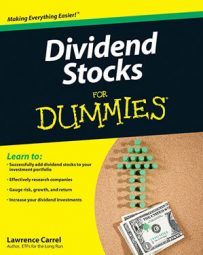According to the dividend connection approach, you buy blue-chip stocks that have dropped in price and attained a historically high yield. You sell when the price is high and the yield is low.
Identifying blue-chip stocks
The first order of business in this strategy is to identify blue-chip stocks, which must meet or exceed all of the following six criteria:
The dividend increased at least five times over the past 12 years.
The stock carries a Standard & Poor’s quality rating of A- or greater.
The company has at least 5 million common shares outstanding.
At least 80 institutions hold the stock.
The company paid dividends for at least 25 years without interruption.
Corporate profits have grown in at least 7 of the last 12 years.
Finding the connection
The connection in dividend connection refers to the link between a stock’s yield and its underlying value. For a stock to be a good value it must post a high yield at a low price. So what constitutes a high yield and a low price?
High yield: A dividend yield comparable to a past high yield that occurred at the end of a big price decline for this particular stock.
Low price: A price comparable to a past low price that coincided with a high dividend yield.
Because each stock and each sector has its own price and yield range, nobody can tell you specifically what’s a high yield or a low price. You must research each stock’s history and examine its peaks and valleys to understand whether today’s price is high or low. The biggest downside to the strategy is you need this data to follow it. The trend’s pattern can take years to appear on a graph, so you have to plot out 5 to 10 years worth of data. Combining Weiss’s book and the Web charts, you can get a graph measuring a company’s price versus yield over 27 years.
A low price and a high yield don’t necessarily signal a good opportunity. They usually mean the company is having problems, such as falling profits, that may result from rising expenses, a poor economy, or poor management. Find out why the price is low and the yield is high before you buy.

